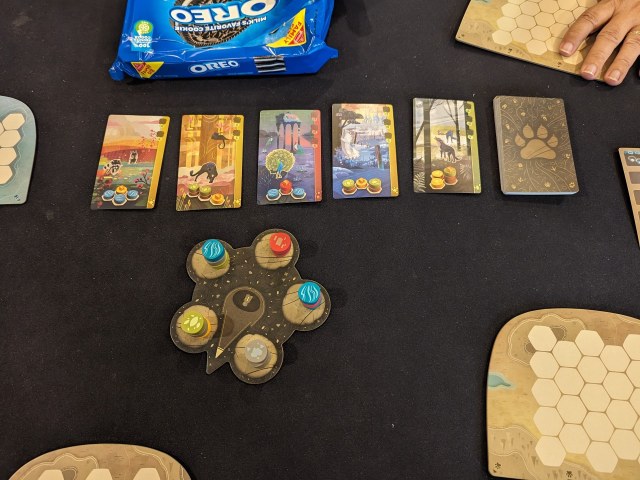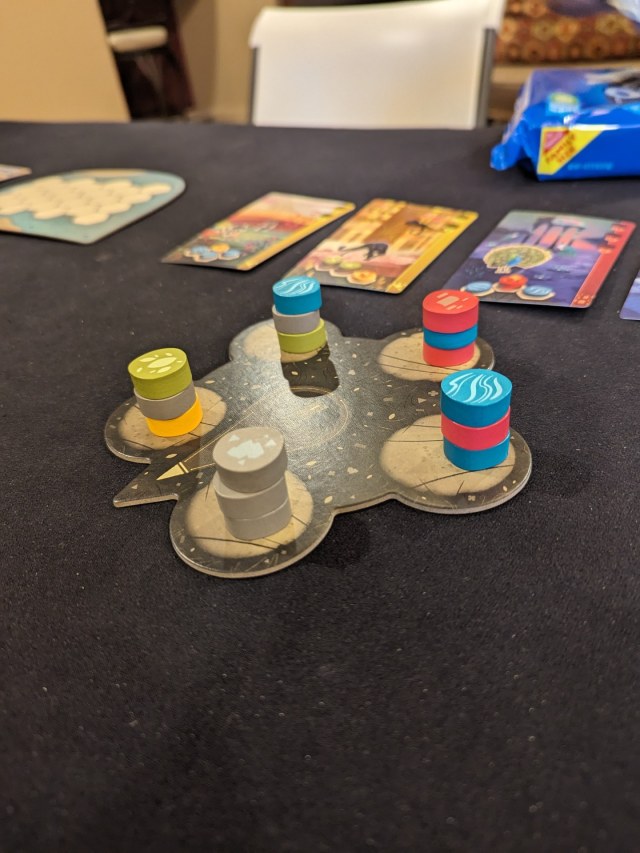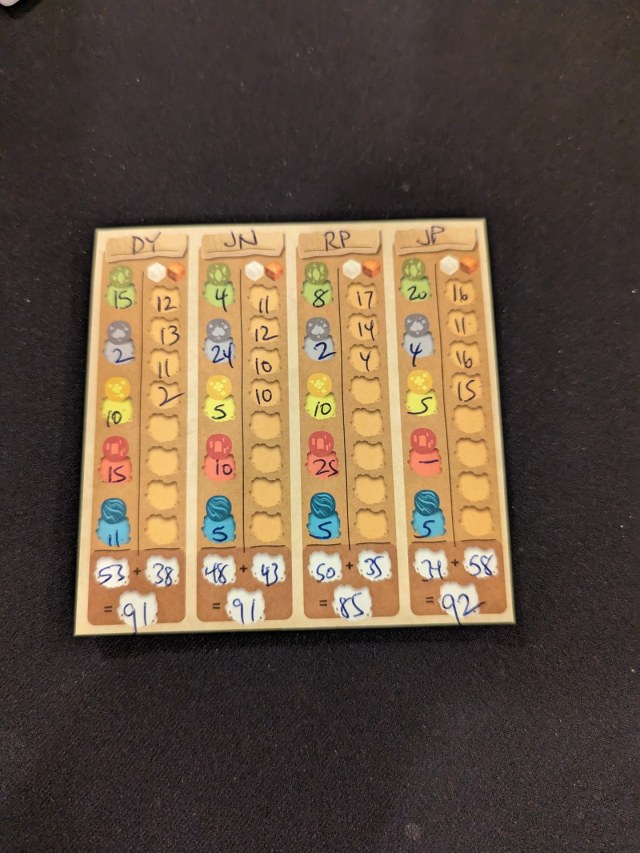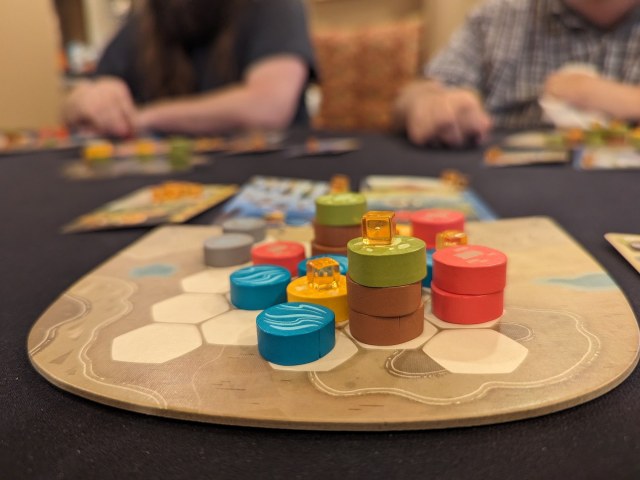Harmonies
- Designer: Johan Benvenuto
- Publisher: Libellud
- Players: 1-4
- Age: 10+
- Time: 30-45 minutes
- Played with review copy provided by publisher
In Harmonies, build landscapes by placing colored tokens and create habitats for your animals. To earn the most points and win the game, incorporate the habitats in your landscapes wisely and have as many animals as you can settle there.
To set up the game, place the starting board on the table and seed each of the 5 spaces with 3 random tokens from the bag. 5 Animal cards are placed faceup in a row – with the remainders forming a deck nearby. Each player takes a player board, and one of the two sides is agreed upon for this game. The player aid card of each player should be flipped to match the side of the board in play. Optionally, deal each player 2 Nature’s Spirit cards, each player chooses one and places it above their board.
Play goes around the table. On a player turn, the active player must take and place tokens once, and they may optionally take an Animal card and optionally place an Animal Cube. These three options can be done in any order.
When you take tokens, you choose any of the five spaces on the central board and take all 3 of the tokens there. These must be placed one-by-one onto the player board. Tokens can always go on empty spaces. Tokens can also be stacked on certain other tokens (or pair of tokens) to form trees, buildings or mountains. The player aid shows you the possible combinations. You can never place a token on an Animal cube.
If you choose to take an Animal card, take any of the five available cards and place it above your board, and fill each space on it with an Animal cube. You are limited to four cards in your possession (this includes your Nature’s Spirit card if you are playing with them. Note that you can only take 1 Animal card per turn.
If you choose to place an Animal cube, you’ll need to meet the criteria. At the bottom of the card, you’ll see a pattern of tokens – and when you have matching tokens on your player board in any orientation (while exactly matching both color and height), you can move the bottom-most Animal cube from the card to your board. Removing cubes will score you points, and if you complete the card by placing all the cubes on it, you move the Animal card to your personal area – and it no longer counts against your limit of 4 cards.
At the end of your turn, refill the space on the Central board which is empty and, if needed, replenish the Animal Card supply to five cards.
The game end is triggered when the pouch is empty or when a player has 2 or fewer unoccupied spaces on their board at the end of their turn. Play continues to the end of the round so that all players have taken the same number of turns. The game then moves to scoring:
- Fields (yellow): 5 points per field (2+ yellow tokens)
- Mountains (grey): 1/3/7 pts per Mountain based on height, but must be next to another Mountain
- Trees (green): 1/3/7 pts per Tree based on height
- Buildings (red): 5 pts per building as long as it has 3+ different colors around it
- Water (blue): different scoring based on board side in play – points either for the length of the longest consecutive line or for islands created by the water
- Animal cards – for each card, score for the highest unoccupied space on each card.
- Nature’s Spirit cards – if you used these, score the card as it were an Animal card
The player with the most points wins. Ties broken in favor of the player with the most Animal cubes placed.
There is also a solo game where you try to get the most Solo points – determined by the number of points you score, the side of the board you use and whether or not you use Nature’s Spirit cards or not. This mode uses the Solo side of the board which only has three spaces for tokens.
My thoughts on the game
I was pretty interested in giving this one a try. I like tile (token) laying games, and Harmonies adds some pattern matching to this basic mechanism. Each turn, you have to choose a set of tokens from the supply – but there are a number of things to consider when choosing.
Each particular token type has its own way of scoring, and you might be choosing tokens simply for that. As you collect Animal cards, you will also be able to move tokens from the card to your board based on matching the patterns of that specific card. As you draft a group of three tokens, you might be working on multiple objectives with each selection. There are definitely plenty of things to think about on your turn and it is rare to have a turn where there is an easy decision.
Due to the shuffling of the Animal deck (and the Nature Spirit cards if you play with them), you’ll have different things to focus on in each game. There are also two sides of the gameboard to play on, and each offers different scoring for the water tokens leading to more variations in your games. The timing of your play also makes a difference as you score Animal cards as you meet the criteria, and then you might build over some of those patterns (though never over the hexes which you have placed the scoring markers on).
Though I’ve only tried it once, I enjoyed the solo game and I thought that it felt very much like the regular game. It was a really good way to learn the flow of the game before I taught it to my regular game group.
I love the way the game looks on the table, and I think that the player board is wonderful to see as it is built up over the course of the game. I do wish that the animal cards had slightly more distinct illustrations to show the patterns; I’ve played in a number of games when a player didn’t correctly see that some tokens were stacked in a pattern and this mistake pretty much screwed up their whole game. I now try to point out what each pattern is as the Animal card is flipped up onto the display, but ideally, the cards would be easier to parse and this wouldn’t be necessary at all.
There is a nice puzzle in each game of Harmonies, and my games are now closer to 30 minutes when I play with other gamers familiar with the rules. There is honestly nothing particularly innovative in Harmonies, but despite that, this is one of those games that just works so well, It’s on the upper end of games I’d play with casual gamers, but it’s one of the rare games that I think could work well with my regular game group as it would with causal non-gamers.
Thoughts from other Opinionated Gamers
Lorna: Love this game. I love the chunkiness of the terrain tokens, the puzzliness of the placement and the upward building and the cute art.
Dan B. (1 play): I like this style of game, and I would like to enjoy this more than I do. It’s got some good elements but overall it fell flat for me. The biggest problem is how the animal cards are implemented: the fact that players all draft their own to work on means no direct competition for them, and the number of cards you can get through combined with the number of ways to score significantly from just the tokens creates a big mush of scoring opportunities which makes a lot of the decisions feel pretty meaningless. Compare it to Cascadia (which it is often compared to): in each game of Cascadia there are just five ways to score animals which everyone shares (so there’s direct competition) and the other kinds of scoring are usually not that important and in any case are very simple.It’s also not possible to luck into a lot of points when a fortuitous card comes up late in the game, which is definitely something that can happen in Harmonies.
Maricel E. When I stumbled upon this game via ThinkerThemer, I knew I HAD to get it. I’m a sucker for tile laying and a gorgeous aesthetic, and when they mentioned its similarity to Cascadia, I was sucked in. Unfortunately, I was late to the party and it was sold out everywhere; I actually had to pay a premium price to get it shipped to me twice (I got suckered the first time by a faux online retailer). I mention this because when I finally got my copy and played it, I wondered if perhaps I was forcing myself to like it because of my steep investment in it. Happily, after several more solo plays, I realized it did live up to its hype and now it’s a happy addition to my collection of tile laying games.
Alan H. Like many others, I discovered the game via YouTube videos and was immediately struck by the simplicity of play, but the cleverness of variety and planning. I prefer 3 player games as this provides more likelihood of gaining your target pieces and the down time is non-existent. It’s an excellent game to introduce to non regular gamers as the rules are easy to teach, but also appeals to more experienced players who need a 20 minute lighter fix at the end of a game session.
Joe Huber (1 play): Harmonies is a pleasant enough game, but one that felt like it could have been significantly better for me. Simply having one set of tiles added each turn, rather than periodically flushing the display and rotating the start player, felt to me like a less dynamic – and less interesting – design choice. And, as Dan notes, the animal cards tend to avoid competition rather than emphasizing it. I still enjoyed the game well enough, but I’m not drawn to a second play; I think with some small changes I might have been.
Ratings from the Opinionated Gamers
- I love it! Lorna, Maricel E, Alan H
- I like it. Dale Y
- Neutral. Eric M, Dan B., Joe H
- Not for me…







I sold Cascadia after playing Harmonies. Harmonies is good, thinky fun. I have 14 different gamer friends that get together and, no lie: every single one of us prefer this over Cascadia.